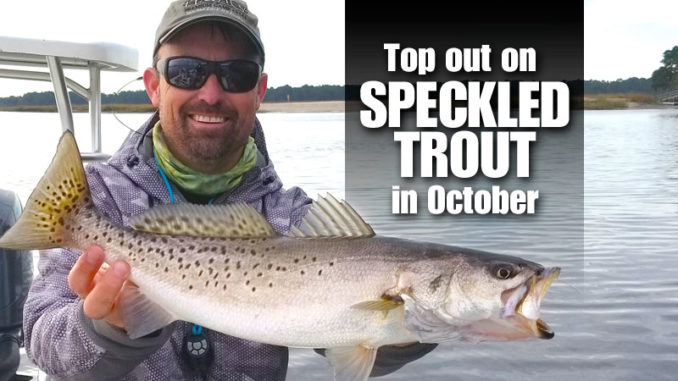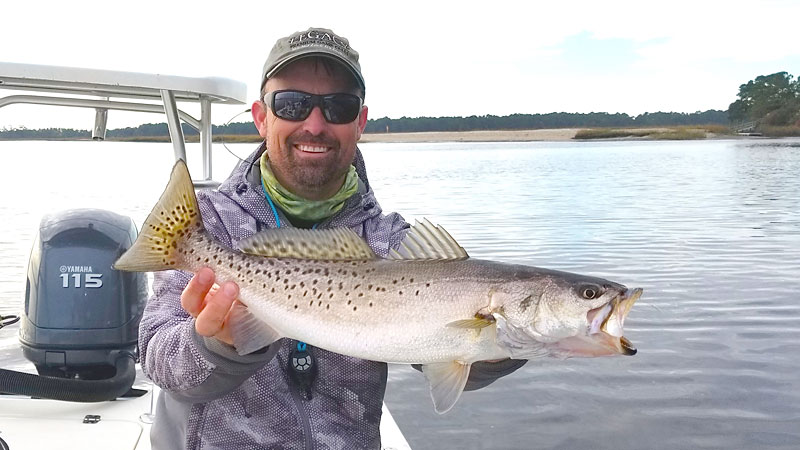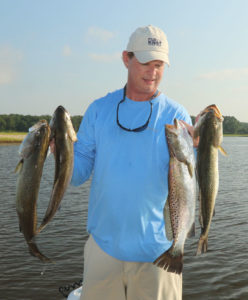
Topwater lures can work all day long this time of year
It’s time to tie on a topwater lure and bust some speckled trout on the surface. The trout bite has been consistent all year across the Carolinas, but something about October’s cooling weather really has these fish in a heightened feeding mood.
Many anglers view the early morning and late evening as prime topwater times, and that’s certainly not a bad outlook. But this time of year, especially when any cloud cover is present, it’s always a good idea to keep a topwater lure at the ready. Some anglers will fish one all day, so if you’re going to throw away conventional wisdom, October is the time to do it.
Trout will bite topwater lures in any depth of water
A few years ago, a friend and I were fishing around the border between North Carolina and South Carolina. We went into a small, but still good-sized creek off of the main waterway. After dropping his trolling motor at the first sign of a very long, oyster-shell bank, my buddy said we’d try it there for a few minutes and then move on to some other spots he knew. We never left that shell bank, and we threw nothing but topwaters all day. The speck bite was absolutely on fire.

We caught them on the rising tide; we caught them at high tide, and we caught them on the falling tide. All we did was move back and forth, covering about 75 yards of oyster bank over and over.
It was a perfect October day. The air was warm but not uncomfortably hot, and the water was quite a bit cooler than it had been a month earlier. We had periods of bright sun, but we also had some occasional cloud cover. The bite seemed to pick up a little when the clouds covered the sun, but even in the bright sun, we caught enough fish to keep at it.
Switch things up
On occasion, the bite would slow a little, but rather than pulling the trolling motor up and moving, we would switch lures. We stayed with topwaters the whole time but went from walk-the-dog lures to popping lures to buzzing lures. Sometimes, we kept the same type of lure but changed either the size, color or both. Each time we changed, the bite would pick up right away.
The main lures we used were Zara Spooks and Zara Spook Jrs., Whopper Ploppers and Pop-Rs, and we used each in a variety of colors. Black/chartreuse was one good combination, bone was a big producer, and clear lures also worked well. A variety of gray or silver patterns also caught their share of fish.

One thing we learned, kind of by accident, was that these fish would bite in a big range of depths. We tried staying a consistent distance from shore, but the tide or the occasional breeze would sometimes push us farther away. On those occasions, we would be over water as deep as 12 feet, and trout were still slamming our surface lures. And we continued catching them in water less a foot deep closer to the bank.
Make adjustments
When “walking the dog” with a Zara Spook, we would give the rod two quick twitches, reel in only the slack, then give two quick twitches. The fish would often hit on the pause as we reeled in the slack. When the fish appeared to shut down, we would adjust the speed of our twitches, change colors or pick up a different lure.
With the Pop-Rs, we twitched the rod tip, reeled in the slack, then repeated. The fisherman never paused, but the lure paused every time the angler reeled in the slack line. Be ready during that pause. If you’re not getting bit, adjust how much you move the lure each time you twitch the rod. And don’t be afraid to change colors of the same lure, especially if the bite slows.
The Whopper Plopper was extremely versatile. Sometimes we reeled it steady, keeping it moving and buzzing it the whole way back to the boat. Other times, we would twitch the rod, moving the lure slightly so it would make its buzzing sound, then pause. Unlike conventional buzzbaits, the Whopper Plopper stays on the surface, even on the pause. For a while, one method would work better than the other, but when the bite slowed, we would switch it up.
That was an exceptional day, and I think one reason it was so much fun and productive is because we committed to using nothing but topwaters all day. And any time the bite seemed to stop, we would simply change lures, colors or our method of retrieval.





Be the first to comment